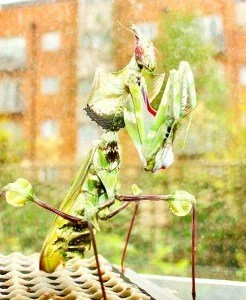Care Sheet - Devil’s Flower Mantis (Idolomantis diabolica)
Written by: Richard’s Inverts
A subadult male Devil’s Flower Mantis (Idolomantis diabolica)
Common Name: Devil’s Flower Mantis
Scientific Name: Idolomantis diabolica
Distribution: Ethiopia, Kenya, Malawi, Somalia, Tanzania, Uganda
Scientific Classification:
Order: Mantodea
Family: Empusidae
Genus: Idolomantis (Uvarov, 1940)
Species: diabolica (Saussure, 1869)
Etymology:
[diabolica] from the Ancient Greek “diabolos” meaning “creature of hell”
Maximum size: Females – 12 cm, Males – 10 cm
Number of moults: Females – 8, Males – 7
Temperature: Day – 30-40°C, Night – 20-25°C
Humidity: 60% RH
Enclosure ize: LxWxH: 30x30x40 cm
Ootheca Incubation:
Temperature: 25-30°C
Length: 6 weeks
Hatch rate: up to 50 nymphs
An adult female Devil’s Flower Mantis (Idolomantis diabolica)
Species Description:
Idolomantis diabolica is an impressive and desirable insect for every mantis keeper. The turquoise colour of the adults and the impressive size, combined with the stunning threat pose make I. diabolica look like a creature from another world.
There are some noticeable differences in the successful husbandry methods for I. diabolica compared to other species, leading early keepers to believe that they were hard to raise and breed in captivity. With the correct care however, they are easy to rear from hatchling to adult. As long as there are a number of adults of each sex, at least one mating is almost always guaranteed. The earliest case of successful breeding for multiple generations was reported on the German Mantis Forum with the IGM25 stock that originated from the Mara region in Tanzania, originally imported in 2004.
Behaviour:
The behaviour that Idolomantis diabolica is most well-known for, called a deimatic display, is a response used to startle or momentarily distract a predator, allowing it to have a short space in which to escape. Both nymphs and adults of I. diabolica possess a unique deimatic display compared to other mantis species, where they will raise their raptorial legs straight up aligned next to each other. This combined with the very wide surface of the legs gives the illusion that the mantis is much larger in size than it actually is. Doing this also exposes the area on the inner surface of the legs, which is brightly coloured in red, white, blue and black.
An adult female Devil’s Flower Mantis (Idolomantis diabolica)
Housing:
As small nymphs, Idolomantis diabolica do not require as much space as adult so they are easy to house in polystyrene drinking cups. The soft polystyrene sides allow the two tarsal claws to easily sink in, giving the nymphs good grip.
If the breeder wishes, Idolomantis diabolica can be kept communally in large net cages but one should always be aware that they will be chances of cannibalism, just like any mantis species, if food becomes scarce. If too many nymphs/adults are kept in a small enclosure, two will often grab the same fly if as they will be in close proximity with one another, which can result in the loss or damage of limbs.
Food:
Young nymphs of Idolomantis diabolica will quite happily accept crawling insects such as roaches and small mealworms, but crickets should be avoided at all costs. Their appetite for crawling food will tail off towards fourth instar however and flying insects will then make up 90% of their preferred food. Some examples of flying prey that can be used are fruit flies, houseflies, green bottle flies and blue bottle flies. In the case of the shortage of flies, it is possible to fool them into taking non-flying prey such as adult roaches by offering the prey on tweezers, held by a wing tip and “whizzed” a few centimetres in front of their faces.
In the UK, fly maggots can cheaply be bought at fishing tackle shops under other names. Below are the 3 varieties that tackle shops stock:
Whites – Blue bottle flies – (Calliphora spp.)
Pinkies – Green bottle flies – (Lucilia spp.)
Squatts – House flies – (Musca spp.)
Humidity:
As older nymphs, Idolomantis diabolica are extremely tolerant of hot and dry conditions compared to other praying mantis species. However, nymphs have greater success during moulting and faster growth when the enclosures are given a good spray every evening. Having a well ventilated enclosure is very important as any water droplets should evaporate during the night, allowing the enclosure to return to the original drier humidity by the morning.
It should also be noted that when I. diabolica are kept bone dry for a long period of time, they will usually go into a state of aestivation until conditions become more favourable again.
Breeding:
4-6 weeks after the moult to adulthood, Idolomantis diabolica will become sexually mature, meaning that they will be ready for breeding. Receptive females will often be seen “calling”, lowering the tip of their abdomen and raising their wings slightly for pheromone release. When ready, males will jump on and mate with the female.

